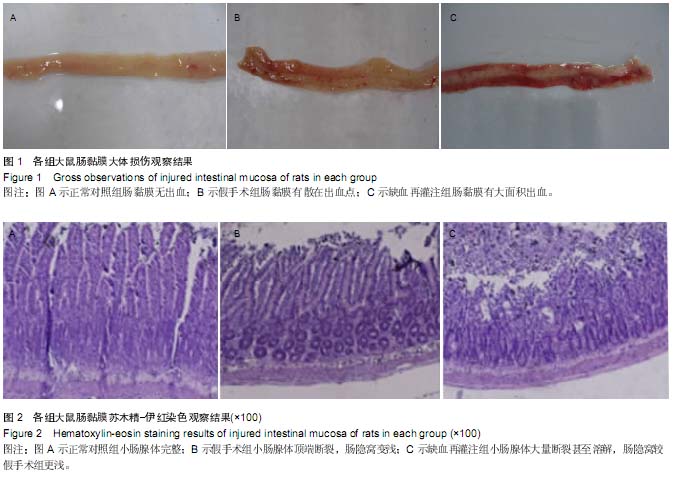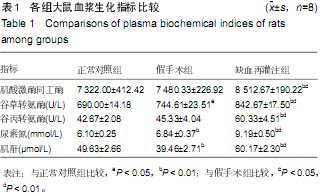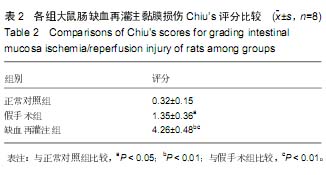| [1] 李继红,曾祥元.血液流变性, LPO及TSA的改变与高原应激综合征[J].微循环技术杂志:临床与实验,2004,8(5):355-356.
[2] 张世范,吴天一.高原缺氧胃肠功能障碍的病理生理[M].北京:人民军医出版社,2004, 9(3):175-177.
[3] Wu TY, Ding SQ, Liu JL, et al. High-altitude gastrointestinal bleeding: an observation in Qinghai-Tibetan railroad construction workers on Mountain Tanggula. World J Gastroenterol. 2007;13(5): 774-780.
[4] Grootjans J, Hameeteman W, Masclee AA, et al. Real-Time in vivo imaging of early mucosal changes during ischemia- reperfusion in human jejunum. PloS one. 2012; 7(6): e39638.
[5] Chassin C, Hempel C, Stockinger S, et al. MicroRNA‐146a‐mediated downregulation of IRAK1 protects mouse and human small intestine against ischemia/reperfusion injury. EMBO Mol Med. 2012;4(12): 1308-1319.
[6] Wang F, Li Q, Wang C, et al. Dynamic Alteration of the Colonic Microbiota in Intestinal Ischemia-Reperfusion Injury. PloS one. 2012;7(7): e42027.
[7] Kinross J, Warren O, Basson S, et al. Intestinal ischemia/reperfusion injury: defining the role of the gut microbiome. Biomark Med. 2009;3(2):175-192.
[8] Grosche A, Morton A, Graham A, et al. Mucosal injury and inflammatory cells in response to brief ischaemia and reperfusion in the equine large colon. Equine Vet J. 2011; 43(s39): 16-25.
[9] Arumugam TV, Okun E, Tang SC, et al. Toll-like receptors in ischemia-reperfusion injury. Shock. 2009;32(1): 4-16.
[10] Liu CJ, Jin JD, Lv TD, et al. Keratinocyte growth factor gene therapy ameliorates ulcerative colitis in rats. World J Gastroenterol. 2011;17(21): 2632-2640.
[11] Wu R, Dong W, Wang Z, et al. Enhancing apoptotic cell clearance mitigates bacterial translocation and promotes tissue repair after gut ischemia-reperfusion injury. Int J Mol Med. 2012;30(3):593-598.
[12] Rivera LR, Pontell L, Cho HJ, et al. Knock out of neuronal nitric oxide synthase exacerbates intestinal ischemia/ reperfusion injury in mice. Cell Tissue Res. 2012; 349(2): 565-576.
[13] Wang Y, Jing Y, Cai Q, et al. Effects of sodium aescinate on the apoptosis-related genes in lung injury induced by intestinal ischemia reperfusion in rats]. Sichuan Da Xue Xue Bao Yi Xue Ban. 2012;43(2):170-173.
[14] K?l?ç K, Hanc? V, Selek ?, et al. The effects of dexmedetomidine on mesenteric arterial occlusion-associated gut ischemia and reperfusion-induced gut and kidney injury in rabbits. J Surg Res. 2012;178(1): 223-232.
[15] Ikemura K, Inoue K, Mizutani H, et al. An antioxidant Trolox restores decreased oral absorption of cyclosporine A after liver ischemia-reperfusion through distinct mechanisms between CYP3A and P-glycoprotein in the small intestine. Eur J Pharmacol. 2012;690(1-3):192-201.
[16] Jing H, Shen G, Wang G, et al. MG132 alleviates liver injury induced by intestinal ischemia/reperfusion in rats: Involvement of the AhR and NFκB pathways. J Surg Res. 2012;176(1): 63-73.
[17] Walensi M, De Groot H, Schulz R, et al. Mesenteric ischemia-reperfusion injury: Clearly improved hemodynamics but only minor protection of the rat small intestine by (sub) therapeutic heparin sodium and enoxaparin doses. J Surg Res. 2013;179(1): e57-e69. |


